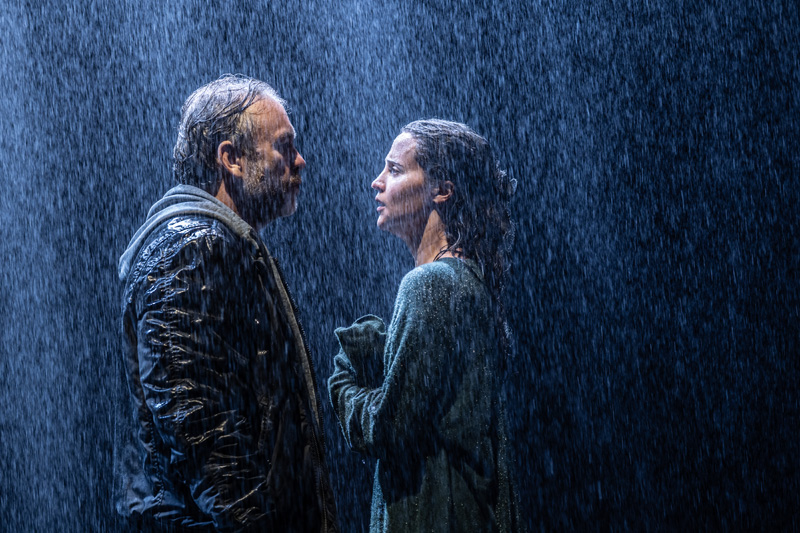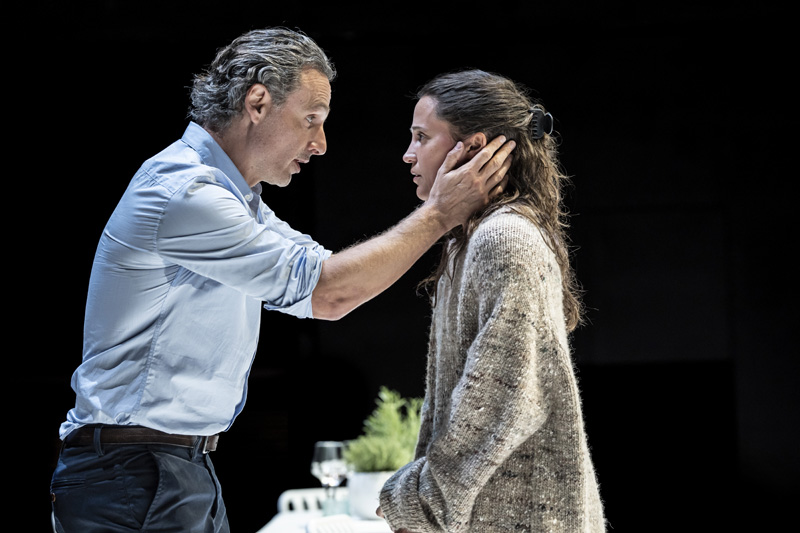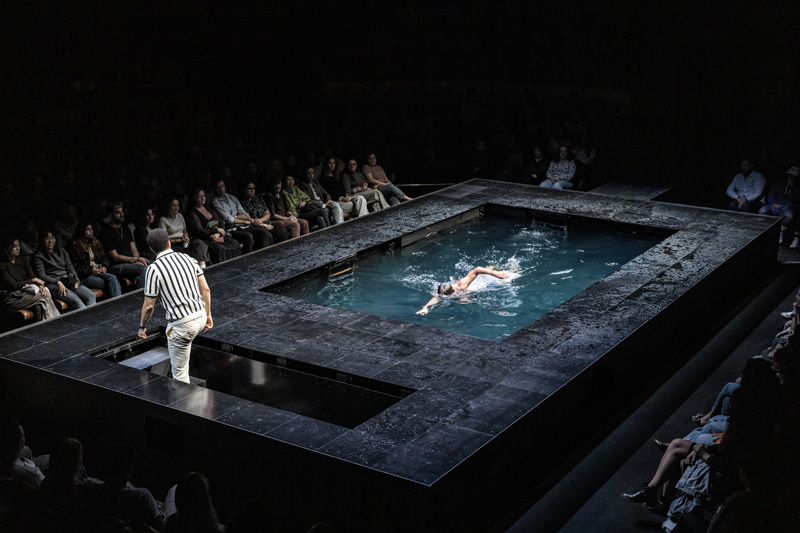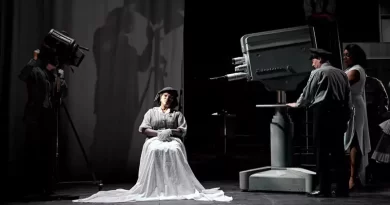“The Lady from the Sea” at the Bridge Theatre
Neil Dowden on the South Bank
19 September 2025
★★★★
Anyone expecting a slice of nineteenth-century Nordic noir from The Lady from the Sea at the Bridge Theatre may be disconcerted. This play is by Simon Stone “after Henrik Ibsen” – and like the Australian theatre-maker’s previous signature shows, including several other Ibsen plays, Lorca’s Yerma (which won an Olivier Award), and Phaedra (after Euripides, Seneca, and Racine), it reimagines the original story and characters in a completely contemporary scenario. Although there are a few Scandinavian references, Stone has convincingly transposed Ibsen’s mysterious psycho-drama drawing on Norwegian folklore into a more naturalistic dark-comedy-drama that critiques our own social conventions.

Brendan Cowell and Alicia Vikander.
Photo credit: Johan Persson.
Set in a Lake District country house, we see the Swedish Ellida struggling to settle into a comfortable English middle-class existence, married to successful neurologist Edward, as they live with his two young daughters Asa and Hilda from his late first wife. It could seem idyllic, but Ellida is haunted by past traumatic experiences that still exercise a powerful force, as a former lover re-emerges after 20 years’ absence to reclaim her.
Although the essence of Ibsen’s play remains, Stone has made significant changes in addition to shifting the setting and modernizing the language. We find out quite early on that Ellida has suffered a miscarriage (not an infant death as in Ibsen), which she blames on herself as punishment for her earlier transgressions. She later confesses to Edward that when a teenager she had a relationship with an older man, Finn, while they were both environmental activists, and that she killed a security guard during a tussle on an oil rig for which Finn took the blame and went to prison. (In the Ibsen, Ellida’s lover is a sailor who murders his captain.) And the ending of the play is very different too, with Ellida’s choice reflecting women’s greater freedom today.
Stone has reinvented other characters too. We hear that Edward’s first wife killed herself, though her motives remain hazy. It could perhaps be linked to racism, as Hilda talks of feeling an outsider in her environment as a woman of dual heritage, and both she and her older sister Asa (who has also not felt able to come out as a lesbian at home) are keen to move away. The close family friend Lyle – like Edward a doctor – is here also black but lives in multicultural Manchester. Finally, awkward distant cousin (from Cornwall!) and would-be sculptor Heath, who receives a terminal diagnosis from Edward, is probably closest to Ibsen.
As well as introducing new issues including suicide, sexual abuse, sexuality, race, and climate change, Stone inserts many popular cultural allusions – including “hipster” sparkling wine pét nat and chilli jams, TikTok, Beyoncé, Terrifier 3, and even namechecking Luigi Mangione, alleged murderer of an insurance CEO in New York. The latter certainly contextualize the drama, though it sometimes feels that Stone is trying to cram in too much.
There is much more humour here than in Ibsen, though the drily witty banter that so many characters engage in especially in the opening scenes becomes a bit irritating in what is a verbose play. Stone tends to spell things out – his characters are constantly self-analysing – while Ibsen’s play had more of an ambivalent poetic, even mythic quality. But the mood transforms in the second act as the emotional intensity increases, so that the essential themes of desire, guilt, grief, and rebirth come through strongly.
Stone’s engaging, in-the-round production always holds our attention, with a fluid staging that especially later on includes overlapping scenes and characters entering from different directions. The stripped-back set design – white in the first act, black in the second – with garden furniture by Lizzie Clachan is also fluid; literally in the second act when there is an extended downpour of rain that drenches the actors whose characters embrace it as a cathartic relief from pent-up emotions, with an impressive coup de théâtre as it transforms into a swimming pool. Nick Schlieper’s effective lighting changes from early sunny brightness to spasmodic flashes as people break down, while Stefan Gregory’s score becomes progressively more discordant.
Photo credit: Johan Persson.
Stone obtains fully committed performances from the whole cast. Swedish film star Alicia Vikander (winner of an Oscar for Best Supporting Actress in The Danish Girl) touchingly reveals the vulnerability of Ellida, with an unhappy, even abusive background, who still feels the pull of the sea, as she grows into a more assertive independence. Andrew Lincoln (in a welcome return to the stage after five years doing mainly TV work) makes a sympathetic, often funny Edward, whose domestic life suddenly crumbles around him, as he painfully learns to accept that his loved ones have a right to forge their own lives.
His two daughters rebel against his overprotectiveness, with Grace Oddie-James’s coolly intelligent Asa (who uses OnlyFans to fund her studies) and the angrier, more unstable Hilda (an assured first professional stage appearance by Isabel Akuwudike) squabbling with each other, but alike in their feisty directness. John Macmillan (who appeared in Stone’s Yerma and Phaedra) is amusing as the ironic Lyle, also a former lover of Ellida’s but a close friend to Edward and their daughters, who has been unable to commit to a relationship himself. Joe Alwyn (also making his stage debut after much screen work) does well to show how the nerdy Heath for the first time is in touch with his feelings as he comes to terms with his mortality. And Brendan Cowell (also in Phaedra) makes a real impact in a performance of understated menace as the eco-warrior Finn who returns to the sea.










